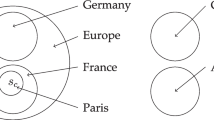Abstract
I argue that maps do not feature predication, as analyzed by Frege and Tarski. I take as my foil (Casati and Varzi, Parts and places, 1999), which attributes predication to maps. I argue that the details of Casati and Varzi’s own semantics militate against this attribution. Casati and Varzi emphasize what I call the Absence Intuition: if a marker representing some property (such as mountainous terrain) appears on a map, then absence of that marker from a map coordinate signifies absence of the corresponding property from the corresponding location. Predication elicits nothing like the Absence Intuition. “F(a)” does not, in general, signify that objects other than a lack property F. On the basis of this asymmetry, I argue that attaching a marker to map coordinates is a different mode of semantic composition than attaching a predicate to a singular term.
Similar content being viewed by others
References
Allwein G., Barwise J. (1996) Logical reasoning with diagrams. Oxford University Press, Oxford
Andrews J.H. (1990) Map and language: A metaphor extended. Cartographica 17: 1–19
Brachman R., Levesque H. (2004) Knowledge representation and reasoning. Elsevier, Boston
Burge T. (2005) Truth, thought, and reason. Oxford University Press, Oxford
Casati R., Varzi A. (1999) Parts and places. MIT Press, Cambridge, MA
Davidson D. (2005) Truth and predication. Harvard University Press, Cambridge, MA
Davis E. (1986) Representing and acquiring geographic knowledge. Morgan Kaufmann, London
Dilworth J. (2002) Varieties of visual representation. Canadian Journal of Philosophy 32: 183–205
Dummett M. (1981) The interpretation of Frege’s philosophy. Duckworth, London
Fodor J. (1975) The language of thought. Thomas Y. Crowell, New York
Goodman N. (1976) Languages of art. Indianapolis, Hackett
Grice P. (1989) Studies in the ways of words. Harvard University Press, Cambridge, MA
Hammer E. (1995) Logic and visual information. CSLI Publications, Palo Alton
Haugeland J. (1998) Having thought. Harvard University Press, Cambridge
Hayes P. (1985) Some problems and non-problems in representation theory. In: Brachman R.J., Levesque H.J.(eds) Readings in knowledge representation. Morgan Kaufmann, Los Altos, pp 3–22
Head C.G. (1984) The map as natural language: A paradigm for understanding. Cartographica 21: 1–32
Heim I., Kratzer A. (1998) Semantics in generative grammar. Blackwell, Malden
Hopkins R. (1995) Explaining depiction. Philosophical Review 104: 425–455
Hopkins R. (1998) Picture, image, and experience. Cambridge University Press, Cambridge
Kitcher P., Varzi A. (2000) Some pictures are worth 2ℵ0 sentences. Philosophy 75: 377–381
Kulvicki J. (2003) Image structure. Journal of Aesthetics and Art Criticism 61: 323–340
Larson R., Segal G. (1995) Knowledge of meaning. MIT Press, Cambridge, MA
Lemmon O., Pratt I. (1999) Putting channels on the map: A channel-theoretic semantics of maps?. In: Moss L., Ginzberg J., Rijke M.(eds) Logic, language, and computation, Vol. 2. CSLI Publications, Stanford, pp 143–164
Leong, M.-K. (1994). Towards a semantics for a visual information system. Dissertation, Stanford University.
Lopes D. (1996) Understanding pictures. Oxford University Press, Oxford
Malinas G. (1991) A semantics for pictures. Canadian Journal of Philosophy 21: 275–298
Millikan R. (2004) Varieties of meaning. MIT Press, Cambridge, MA
O’Brien G., Opie J. (2004) Notes towards a structuralist theory of mental representation. In: Clapin H., Staines P., Slezak P.(eds) Representation in mind: New approaches to mental representation. Elsevier, Boston, pp 1–20
Peacocke C. (1987) Depiction. Philosophical Review 96: 383–410
Potter D. (2006) Diagrammatic representation in geometry. Dialectica 60: 369–382
Pratt I. (1993) Map semantics. In: Frank A., Campari I.(eds) Spatial information theory: A theoretical basis for GIS. Springer-Verlag, Berlin, pp 77–91
Rescorla, M. Chrysippus’s dog as a case study in non-linguistic cognition. In R. Lurz (Ed.), The philosophy of animal minds. Cambridge: Cambridge University Press (Forthcoming a).
Rescorla, M. Cognitive maps and the language of thought. British Journal for the Philosophy of Science (Forthcoming b).
Russell, B. (1923). Vagueness. Reprint in J. Slate (Ed.), The collected papers of Bertrand Russell (Vol. 9, pp. 147–154). London: Unwin Hyman.
Schlichtmann H. (1979) Codes in map communication. Canadian Cartographer 16: 81–97
Sellars W. (1979) Naturalism and ontology. Atascadero, Ridgeview
Shin S.-J. (1994) The logical status of diagrams. Cambridge University Press, Cambridge
Sloman A. (1978) The computer revolution in philosophy. The Harvester Press, Hassocks
Sloman A. (1985) Afterthoughts on analogical representations. In: Brachman R.J., Levesque H.J.(eds) Readings in knowledge representation. Morgan Kaufmann, Los Altos, pp 432–439
Sober E. (1976) Mental representations. Synthese 33: 101–148
Strawson P.F. (1971) Logico-linguistic papers. Methuen, London
Tolman E. (1948) Cognitive maps in rats and men. Psychological Review 55: 189–208
Walton K. (1973) Pictures and make-believe. Philosophical Review 82: 283–319
Author information
Authors and Affiliations
Corresponding author
Rights and permissions
About this article
Cite this article
Rescorla, M. Predication and cartographic representation. Synthese 169, 175–200 (2009). https://doi.org/10.1007/s11229-008-9343-5
Received:
Accepted:
Published:
Issue Date:
DOI: https://doi.org/10.1007/s11229-008-9343-5




